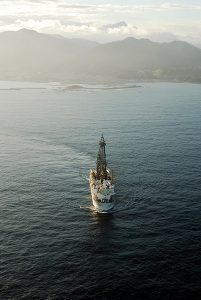
Ever think about taking a fault’s temperature? What would you learn? A unique experiment where temperature was continuously measured for nearly a year inside the fault that made the catastrophic 2011 magnitude 9.0 Japan Earthquake reveals the thermal signature of pulses of water squirting out of fractures in response to other earthquakes on neighboring faults.
The experiment required measurements more than 7 km (4.5 miles) beneath the sea surface in a borehole observatory stretching nearly a kilometer (more than a half mile) underground as part of the Integrated Ocean Drilling Program’s Japan Trench Fast Drilling Project.
The results illustrate how water pressure within fault zones, which influences the susceptibility of faults to slip, can be disturbed by earthquakes on other faults. The observation of interactions between faults during the aftermath of a major earthquake helps scientists gain a better understanding of the processes that control earthquake occurrence.
The research, supported by a grant from the Gordon and Betty Moore Foundation, was conducted by researchers from Texas A&M University and the University of California Santa Cruz.
Reference:
Patrick M. Fulton, Emily E. Brodsky. In situobservations of earthquake-driven fluid pulses within the Japan Trench plate boundary fault zone. Geology, 2016; G38034.1 DOI: 10.1130/G38034.1
Note: The above post is reprinted from materials provided by Geological Society of America.










